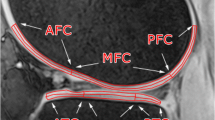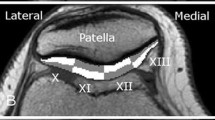Abstract
Objective
The purpose of our study was to assess T2 and T2* relaxation time values of patella cartilage in healthy volunteers using three different coils at 3.0 Tesla MRI and their influence on the quantitative values.
Methods
Fifteen volunteers were examined on the same 3-Tesla MR unit using three different coils: (i) a dedicated eight-channel knee phased-array coil; (ii) an eight-channel multi-purpose coil, and (iii) a one-channel 1H surface coil. T2 and T2* relaxation time measurements were prepared by a multi-echo spinecho respectively a gradient-echo sequence. A semi-automatic region-of-interest analysis was performed for patella cartilage. To allow stratification, a subregional analysis was carried out (deep-superficial cartilage layer). Statistical analysis-of-variance was performed.
Results
The mean quantitative T2 values showed statistically significant differences in all comparison combinations. The differences between the mean quantitative T2* values were slightly less pronounced than the T2 evaluation and only the comparison between (i) and (ii) showed a significant difference. The results of T2 and T2* values showed, independent of the used coil, higher values in the superficial zone compared to the deep zone (p < 0.05). Looking at the signal alterations, all coils showed clearly higher values (and thus more signal alterations as a sign of noise) in the deep layer. The validation of the reliability showed a high intra-class correlation coefficient and hence a very high plausibility (ICC was between 0.870 and 0.905 for T2 mapping and between 0.879 and 0.888 for T2* mapping).
Conclusions
The present results demonstrate that biochemical T2 and T2* mapping is significantly dependent on the utilized coil.



Similar content being viewed by others
References
Felson DT. Clinical practice. Osteoarthritis of the knee. N Engl J Med. 2006;354(8):841–8.
Chung CB, Frank LR, Resnick D. Cartilage imaging techniques: current clinical applications and state of the art imaging. Clin Orthop Relat Res. 2001;391(Suppl):S370–8.
Burstein D, Gray M, Mosher T, Dardzinski B. Measures of molecular composition and structure in osteoarthritis. Radiol Clin N Am. 2009;47(4):675–86.
Mamisch TC, Hughes T, Mosher TJ, Mueller C, Trattnig S, Boesch C, et al. T2 star relaxation times for assessment of articular cartilage at 3 T: a feasibility study. Skeletal Radiol. 2012;41(3):287–92.
Regatte RR, Schweitzer ME. Novel contrast mechanisms at 3 Tesla and 7 Tesla. Semin Musculoskelet Radiol. 2008;12(3):266–80.
Mosher TJ, Dardzinski BJ. Cartilage MRI T2 relaxation time mapping: overview and applications. Semin Musculoskelet Radiol. 2004;8(4):355–68.
Burstein D, Velyvis J, Scott KT, Stock KW, Kim YJ, Jaramillo D, et al. Protocol issues for delayed Gd(DTPA)(2-)-enhanced MRI (dGEMRIC) for clinical evaluation of articular cartilage. Magn Reson Med Off J Soc Magn Reson Med Soc Magn Reson Med. 2001;45(1):36–41.
Potter K, Butler JJ, Horton WE, Spencer RG. Response of engineered cartilage tissue to biochemical agents as studied by proton magnetic resonance microscopy. Arthritis Rheum. 2000;43(7):1580–90.
Eckstein F, Kunz M, Hudelmaier M, Jackson R, Yu J, Eaton CB, et al. Impact of coil design on the contrast-to-noise ratio, precision, and consistency of quantitative cartilage morphometry at 3 Tesla: a pilot study for the osteoarthritis initiative. Magn Reson Med Off J Soc Magn Reson Med Soc Magn Reson Med. 2007;57(2):448–54.
Dietrich O, Reiser MF, Schoenberg SO. Artifacts in 3-T MRI: physical background and reduction strategies. Eur J Radiol. 2008;65(1):29–35.
Dietrich O, Raya JG, Reeder SB, Reiser MF, Schoenberg SO. Measurement of signal-to-noise ratios in MR images: influence of multichannel coils, parallel imaging, and reconstruction filters. J Magn Reson Imaging. 2007;26(2):375–85.
Raynauld JP, Martel-Pelletier J, Berthiaume MJ, Labonte F, Beaudoin G, de Guise JA, et al. Quantitative magnetic resonance imaging evaluation of knee osteoarthritis progression over two years and correlation with clinical symptoms and radiologic changes. Arthritis Rheum. 2004;50(2):476–87.
Balamoody S, Williams TG, Waterton JC, Bowes M, Hodgson R, Taylor CJ, et al. Comparison of 3T MR scanners in regional cartilage-thickness analysis in osteoarthritis: a cross-sectional multicenter, multivendor study. Arthritis Res Ther. 2010; 12(5):R202.
Glaser C, Mendlik T, Dinges J, Weber J, Stahl R, Trumm C, et al. Global and regional reproducibility of T2 relaxation time measurements in human patellar cartilage. Magn Reson Med Off J Soc Magn Reson Med Soc Magn Reson Med. 2006;56(3):527–34.
Mosher TJ, Zhang Z, Reddy R, Boudhar S, Milestone BN, Morrison WB, et al. Knee articular cartilage damage in osteoarthritis: analysis of MR image biomarker reproducibility in ACRIN-PA 4001 multicenter trial. Radiology. 2011;258(3):832–42.
Chang G, Wiggins GC, Xia D, Lattanzi R, Madelin G, Raya JG, et al. Comparison of a 28-channel receive array coil and quadrature volume coil for morphologic imaging and T2 mapping of knee cartilage at 7T. J Magn Reson Imaging. 2012;35(2):441–8.
Eckstein F, Burstein D, Link TM. Quantitative MRI of cartilage and bone: degenerative changes in osteoarthritis. NMR Biomed. 2006;19(7):822–54.
Koff MF, Parratte S, Amrami KK, Kaufman KR. Examiner repeatability of patellar cartilage T2 values. Magn Reson Imaging. 2009;27(1):131–6.
Acknowledgements
Support for this study was provided by the German Research Fondation (DFG) - DACH Grant WE 4881/1 "Multi-parametric visualization of knee joint ultra-structure: Validation of biochemical magnetic resonance imaging from bench to bedside".
Conflict of interest
None.
Author information
Authors and Affiliations
Corresponding author
Electronic supplementary material
Below is the link to the electronic supplementary material.
ESM 1
(JPEG 26 kb)
High Resolution Image
(TIFF 93 kb)
Rights and permissions
About this article
Cite this article
Pachowsky, M.L., Trattnig, S., Apprich, S. et al. Impact of different coils on biochemical T2 and T2* relaxation time mapping of articular patella cartilage. Skeletal Radiol 42, 1565–1572 (2013). https://doi.org/10.1007/s00256-013-1699-z
Received:
Revised:
Accepted:
Published:
Issue Date:
DOI: https://doi.org/10.1007/s00256-013-1699-z




